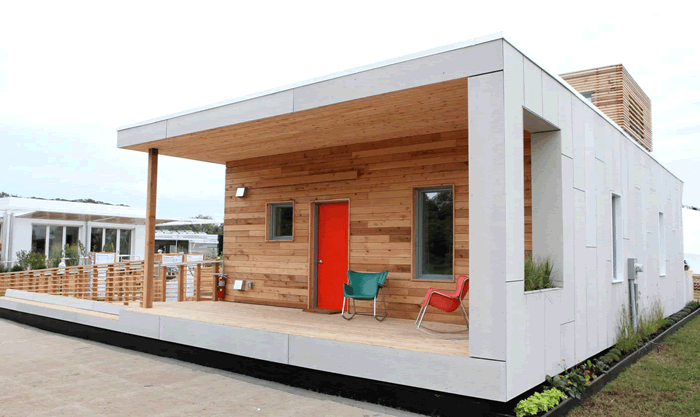SOLAR DECATHLON TEAM CREATES NEW MODEL FOR AFFORDABLE, GREEN HOUSINGThe New School and Stevens Institute of Technology Take Competition Beyond the National Mall by Partnering with Habitat for Humanity and DC Government |
“Going into this competition, we knew that we wanted to build a house that would be more than simply an exhibition piece, and would make a lasting impact on a local community in Washington, D.C.,” said Joel Towers, executive dean of Parsons The New School for Design. “This project illustrates Parsons' commitment to sustainable design, and to confronting the complex problem of climate change that is so imperative for America and the world. We are also happy to be creating a new model for affordable housing that Habitat for Humanity can replicate globally.” The Solar Decathlon is a biannual, international competition that challenges 19 collegiate teams to design, build, and operate solar-powered houses, which will be exhibited on the National Mall Sept. 23—Oct. 2, 2011. The Empowerhouse team has taken the competition beyond the Mall by designing and constructing a house for a specific site in the Deanwood neighborhood east of the Anacostia River in Washington, D.C. At the conclusion of the competition, it will be moved to Deanwood and expanded into a two-family home for local residents in collaboration with DC Habitat and the DHCD. Recently, DC Habitat selected one of the two families that will occupy the final house: Lakiya Culley, a Deanwood resident and single mother of three young children who works as a secretary for the U.S. Department of State. “This project has given students an extraordinary opportunity to address first-hand one of the most pressing problems facing the world today – affordable, sustainable housing supported by alternative energy,” said Dr. Michael Bruno, dean of the Charles V. Schaefer Jr., School of Engineering and Science at Stevens Institute of Technology. “The team has set itself apart by designing a house that is not only net energy neutral but also requires low energy consumption to operate—a welcomed feature for the Washington, D.C. family that will be living there.” Deanwood, a primarily working-class, African-American community, was selected as the site for the project due to its location in one of the greenest wards in Washington, D.C., and its history of community activism and self-sufficiency. Today, Deanwood and its surrounding neighborhoods are undergoing a powerful revitalization through economic development and environmental sustainability initiatives. Residents recently participated in the CarbonFree DC “Extreme Green Neighborhood Makeover,” which green retrofitted low- and moderate-income homes; in addition, the neighborhood is part of Groundwork Anacostia River DC, which brings environmental education and restoration projects to the communities along the river. Groundwork Anacostia will be hosting tours of the Deanwood revitalization efforts during the Decathlon, on September 24 and 25. For more information please visit groundworkdc.org. Building on the theme of self-sufficiency, the house is designed not only to provide its own energy needs, but the team also is working with Deanwood's Lederer Community Youth Garden to provide plantings for a roof garden and vegetable window boxes, to provide families with the opportunity to grow their own food. The house has a comprehensive water strategy that includes a rainwater harvesting system that will capture and store rainwater not only from the site but also from surrounding homes for use in the garden, with the ultimate goal of minimizing the water that is drained into the public sewer system. “Empowerhouse is an excellent demonstration of our commitment to creating sustainable, affordable housing for the residents of the District of Columbia. DHCD is pleased that Parsons, Milano, Stevens and DC Habitat are bringing this innovative and forward-thinking project to the District,” said DHCD Director John E. Hall. “This project provides a unique opportunity for the city and for the Deanwood community, and we expect that it will set a precedent for future Passive Houses in the nation's capital and across the country.” The community will play a direct role in building the house, in keeping with the Habitat for Humanity mission, and the house features an innovative panelization system that will make it easy for construction by volunteers, as well as many off-the-shelf components that are available in home improvement stores. “Energy efficient design results in healthier, more economically viable housing for the low-income families we serve,” said Kent Adcock, President & CEO of Habitat for Humanity of Washington, D.C. “When design ingredients like those of the Empowerhouse reduce energy consumption by up to 90 percent, it's a substantial savings to homeowners, possibly the difference between having access to childcare or healthcare, or even advancing their education.” In developing the project, the Empowerhouse team hosted design charrettes with community members, and conducted extensive research on the neighborhood, including its rich architectural history and sustainable practices and resources. In addition to creating new residences, the team has extended the project by leading workshops to educate residents on how to make their homes more sustainable—from retrofitting solar panels to community gardening. The team is also creating a new learning garden in Deanwood, working with Groundwork Anacostia and local volunteers, and will be hosting volunteer sessions on September 24 and 25. For more information, visit groundworkdc.org. “The team has taken a whole-life approach that reflects the students' wide range of expertise,” said Neil Grabois, dean of the Milano School of International Affairs, Management and Urban Policy at The New School. “Sustainability stands at the intersection of a number of fields. From beginning to end, Empowerhouse has brought together over 200 graduate and undergraduate students with backgrounds in management, urban policy, engineering, and design—from architecture to fashion design, product design, communication design, and design and technology—taking a fully interdisciplinary embrace of this challenge.” For more information, visit www.empowerhouse-dc.org. Empowerhouse is made possible in part through the support of its sponsors, which include Binational Softwood Lumber Council, General Growth Properties Inc., Naturally:Wood, Jones Lang LaSalle, Sheila Johnson and The Washington Mystics, Tess Dempsey, U.S. Department of Energy Solar Decathlon, District Department of the Environment, Dow Solar, MetLife Foundation, the John L. Tishman Scholarships for Sustainable Development, AirDye, Bosch, Buro Happold, Case Design, Inc., Cefas LLC, Delta Contracting Services, Dewberry, Eastern Millwork, Inc., Enterprise Community Partners Inc., Federal Home Loan Bank of San Francisco, Huber Engineered Woods, Intus Consulting, M/E Engineering P.C., National Fiber, Nordic Engineered Wood, Scholes Electric and Communications, Wolfe House Movers, Zehnder 8x8 Construction Inc, A. Joseph Schneider, Airgenerate, AltPower, Blu Dot Furniture, Boswell Engineering, Brultech Research, Clune Construction, CR Studio, D.C. Greenworks, Dee McDonald Miller, Delta Contracting Services, Dolana & Traynor, DMY Engineering Consultants, LLC, Dwell Studio, EcoFriendly Printers, EnOcean Alliance, F&G Mechanical, FreeState Electrical, FLOR, Hafele, Humanscale, Intesis Software, Jair Lynch Development Partners, Kohler, Levis Lighting Science Group, Loomstate, Marmo Enterprises, Inc., Michele Miller, Mitsubishi Electric, My Green Neighborhood, Passive House Institute US, Perkins + Will, ReVirio, Robert F & Julia Anne E. Bilicki, Robin Noble, Scholes Electric & Communications, SCL Elements, Sika Sarnafil, SIGA, Thermokon Sensortechnik, Tyco, UmProject, ValleyCrest Landscape Companies, Viega, Vitra, Vegetal I.D., Whirlpool and Zavos Architecture+Design. |
| Parsons The New School for Design and Milano School of International Affairs, Management and Urban Policy are vital parts of The New School, a university with a legacy of progressive ideals, scholarship, and pedagogy. One of world's leading schools of art and design education, Parsons offers undergraduate and graduate degrees in the full spectrum of disciplines, creatively and critically addressing the complexities of life in the 21st century. Milano trains leaders for the nonprofit, public, and private sectors, blending theory with hands-on practice, and progressive thinking with social commitment. For more information visit www.newschool.edu.
Founded in 1870, Stevens Institute of Technology, The Innovation University TM, lives at the intersection of industry, academics and research. The University's students, faculty and partners leverage their collective real-world experience and culture of innovation, research and entrepreneurship to confront global challenges in engineering, science, systems and technology management. Stevens offers baccalaureate, master's, certificates and doctoral degrees in engineering, the sciences and management, in addition to baccalaureate degrees in business and liberal arts. For more information visit www.stevens.edu. The D.C. Department of Housing and Community Development creates and preserves opportunities for affordable housing and economic development and to revitalize underserved communities in the District of Columbia. The department fulfills its mission by providing gap financing; increasing first-time homeownership opportunities; providing funding to rehabilitate single-family and multi-family homes; supporting communities through neighborhood based activities; providing funding for homelessness prevention; addressing vacant and abandoned properties; and overseeing the administration of rental housing laws. For more information, visit www.dhcd.dc.gov. # # # |
 |
COMMUNICATIONS AND EXTERNAL AFFAIRS |
| 79 Fifth Avenue, New York, NY 10003 www.newschool.edu |
PRESS RELEASE |
Media Contacts: Deborah Kirschner, The New School Noah Lichtman, Stevens Institute of Technology Heather Phibbs, Habitat for Humanity of Washington, DC Najuma Thorpe, DHCD |
|
|
